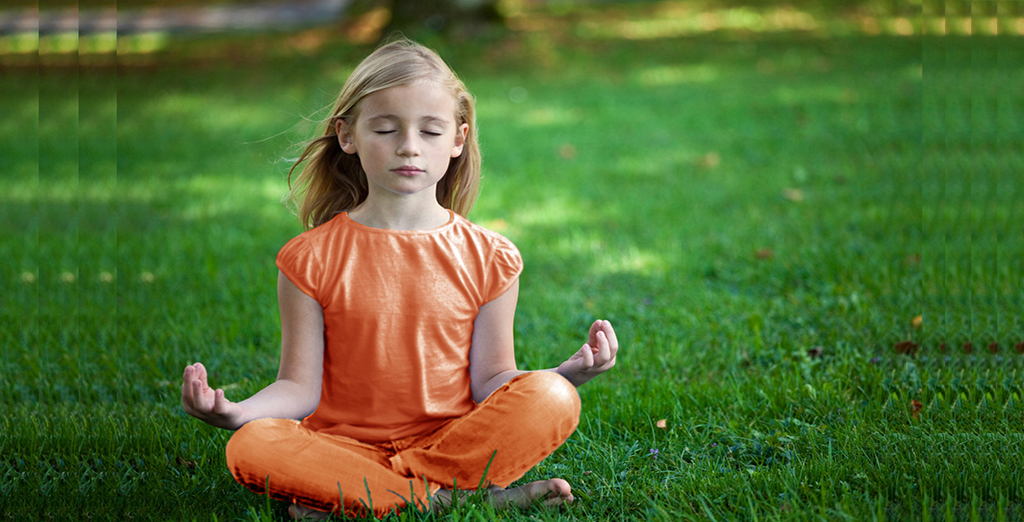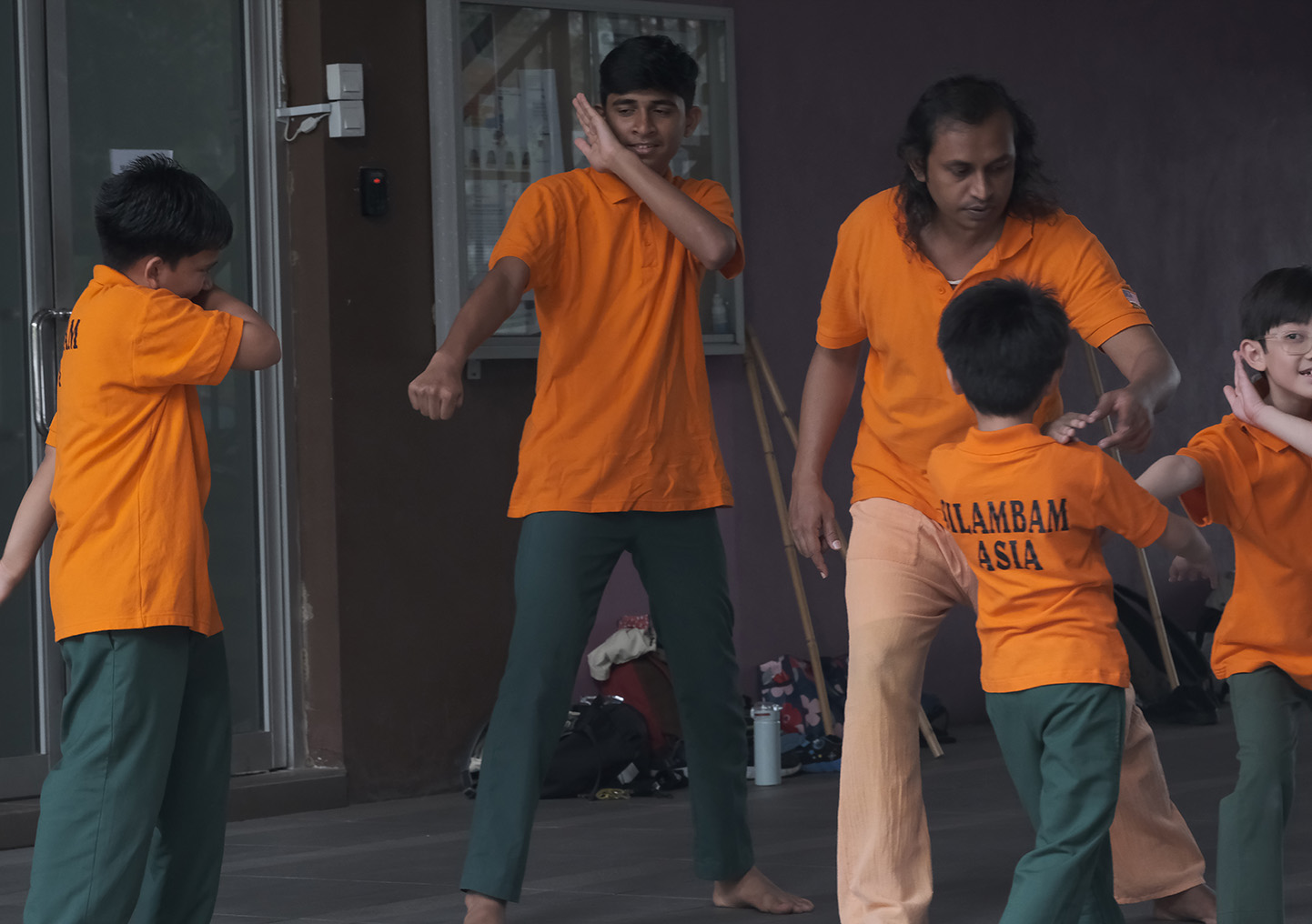
Silambam Mastery
Studies & Trainings
English pronunciation : not_available / Sanskrit संस्कृतम् : not_available / Tamil தமிழ் : சக்கரம் (Cakra)
Bahasa Melayu : Chakra (Roda Tenaga Batin) / Malayalam : not_available / Telugu : సప్తచక్రాలు (Saptacakralu) / Français : Chakra
Chakra - Wheels of Energy
Bahasa Melayu : Chakra (Roda Tenaga Batin) / Malayalam : not_available / Telugu : సప్తచక్రాలు (Saptacakralu) / Français : Chakra
The word chakra is derived from the Sanskrit word meaning wheel. If we were able to see the chakras ( as many psychics, in fact, do ) we would observe a wheel of energy continuously revolving or rotating.
The Sound of the Chakras - "Lam, Vam, Ram, Yam, Ham, Om, Om" each accordingly to each chakra ( from bottom to top ). We created this image for easier to understand.
The Chakras and the Corresponding Talents and Traits
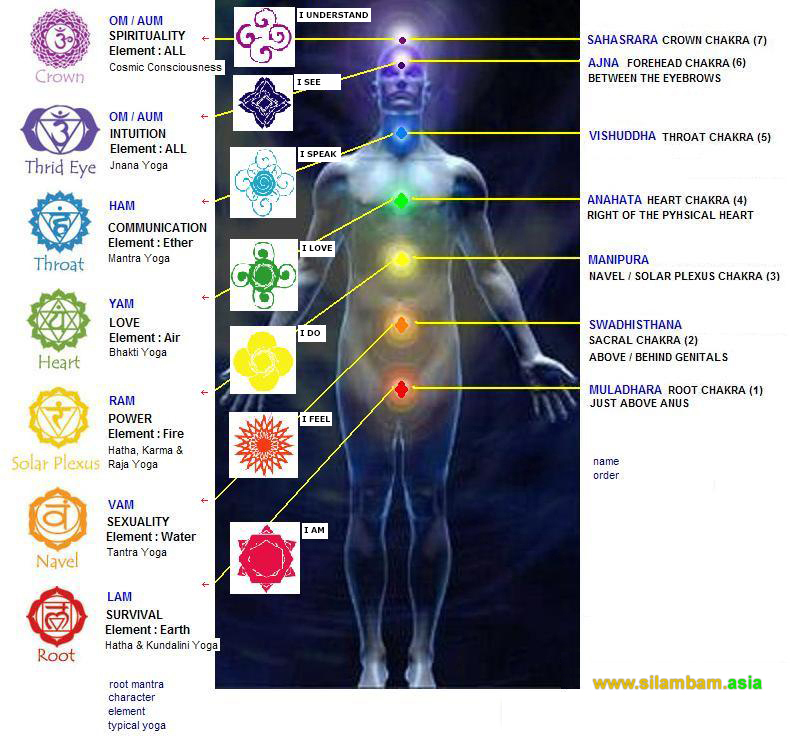
Courtesy : This chakra designed with comprehensive details by Guruji Murugan Chillayah, for easy understanding.
Part I - Study of the Chakras
The word chakra is derived from the Sanskrit word meaning wheel. If we were able to see the chakras ( as many psychics, in fact, do ) we would observe a wheel of energy continuously revolving or rotating. Clairvoyants perceive chakras as colorful wheels or flowers with a hub in the center. The chakras begin at the base of the spine and finish at the top of the head. Though fixed in the central spinal column they are located on both the front and back of the body, and work through it.
Each chakra vibrates or rotates at a different speed. The root or first chakra rotates at the slowest speed, the crown or seventh chakra at the highest speed. Each chakra is stimulated by its own and complimentary color, and a range of gemstones for specific uses. The chakra colors are of the rainbow; red, orange, yellow, green, blue, indigo, and violet. The size and brightness of the wheels vary with individual development, physical condition, energy levels, disease, or stress.
If the chakras are not balanced, or if the energies are blocked, the basic life force will be slowed down. The individual may feel listless, tired, out of sorts, or depressed. Not only will physical bodily functions be affected so diseases may manifest, but the thought processes and the mind may also be affected. A negative attitude, fear, doubt, etc. may pre-occupy the individual.
A constant balance between the chakras promotes health and a sense of well-being. If the chakras are opened to much, a person could literally short-circuit themselves with too much universal energy going through the body. If the chakras are closed, this does not allow for the universal energy to flow through them properly which may also lead to disease.
Most of us react to unpleasant experiences by blocking our feeling and stopping a great deal of our natural energy flow. This affects the maturation and development of the chakras. Whenever a person blocks whatever experience he is having, he in turn blocks his chakras, which eventually become disfigured. When the chakras are functioning normally, each will be open, spinning clockwise to metabolize the particular energies needed from the universal energy field.
As already mentioned any imbalances that exist within any chakra may have profound effects upon either our physical or emotional bodies. We are able to use our quartz crystals and gemstones to re-balance all our chakric centers and once the chakra has been properly balanced then our body will gradually return to normal.
The reason why crystals and gemstones are wonderful and powerful healing tools are because of what science calls its piezoelectric effect. ( You can see this effect in the modern quartz watches ). Crystals and gemstones respond to the electricity that is coursing through our body, and if the energy is sluggish,the constant electrical vibrations of the stones will help to harmonize, balance, and stimulate these energies.
Root chakra ( Muladhara )

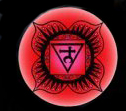
Vitality, a sense of connection with Earth, basic trust, self-confidence, a sense of security in harmony with the laws of nature.
Studying the individual chakras begins with the root chakra, called Muladhara in Sanskrit. The root chakra is located at the base of the spine at the tail-bone in back, and the pubic bone in front. This center holds the basic needs for survival, security and safety. The root chakra is powerfully related to our contact with the Earth Mother, providing us with the ability to background into the earth plane. This is also the center of manifestation. When you are trying to make things happen in the material world, business or material possessions, the energy to succeed will come from the first chakra. If this chakra is blocked an individual may feel fearful, anxious, insecure and frustrated. Problems like obesity, anorexia nervosa, and knee troubles can occur. Root body parts include the hips, legs, lower back and sexual organs. The colors used for this chakra are red, brown and black. The gemstones are Garnet, Smoky Quartz, Obsidian, and Black Tourmaline.
Belly (Sacral) chakra ( Swadhisthana )

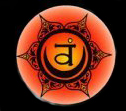
Survival of the species, sexuality, family, sociableness, creativity, solidarity with the surrounding world.
The next chakra or second chakra is often referred to as the belly or (sacral). It is located two inches below the navel and is rooted into the spine. This center holds the basic needs for sexuality, creativity, intuition, and self-worth. This chakra is also about friendliness, creativity, and emotions. It governs peoples sense of self-worth, their confidence in their own creativity, and their ability to relate to others in an open and friendly way. It's influenced by how emotions were expressed or repressed in the family during childhood. Proper balance in this chakra means the ability to flow with emotions freely and to feel and reach out to others sexually or not. If this chakra is blocked a person may feel emotionally explosive, manipulative, obsessed with thoughts of sex or may lack energy. Physical problems may include, kidney weakness, stiff lower back, constipation, and muscle spasms. Belly body parts include sexual organs (women), kidneys, bladder, and large intestine. The main color used with this chakra is orange. The gemstones are Carnelian Agate, Orange Calcite and Tigers Eye.
Solar plexus chakra ( Manipuraka )


Powers of imagination, visions of the future, desire for action, coming to terms with the past, decomposition; the inner fire that creates and destroys.
The third chakra is referred to as the Solar Plexus. It is located two inches below the breastbone in the center behind the stomach. The third chakra is the center of personal power, the place of ego, of passions, impulses, anger and strength. It is also the center for astral travel and astral influences,receptivity of spirit guides and for psychic development. When the Third Chakra is out of balance you may lack confidence, be confused, worry about what others think, feel that others are controlling your life, and may be depressed. Physical problems may include digestive difficulties, liver problems, diabetes, nervous exhaustion, and food allergies. When balanced you may feel cheerful,outgoing, have self-respect, expressive, enjoy taking on new challenges, and have a strong sense of personal power. The body parts for this chakra include the stomach, liver, gall bladder, pancreas, and small intestine. The main color for this chakra is yellow. The gemstones are Citrine, Topaz, and Yellow Calcite.
Heart chakra ( Anahata )

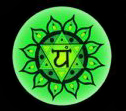
Love of life, joy, love, affection; source of unconditional, selfless love toward fellow human beings, every creature, every element, and the entire Creation.
The fourth chakra is referred to as the heart chakra. It is located behind the breast bone in front and on the spine between the shoulder blades in back. This is the center for love, compassion and spirituality. This center directs one's ability to love themselves and others, to give and to receive love. This is also the chakra connecting body and mind with spirit. Almost everyone today has a hard, hurt, or broken heart, and it is no accident that heart disease is the number one killer in America today. Deep heart hurts can result in aura obstructions called heart scars. When these scars are released, they raise alot of old pain, but free the heart for healing and new growth. When this chakra is out of balance you may feel sorry for yourself, paranoid, indecisive, afraid of letting go, afraid of getting hurt, or unworthy of love. Physical illnesses include heart attack, high blood pressure, insomnia, and difficulty in breathing. When this chakra is balanced you may feel compassionate, friendly, empathetic, desire to nurture others and see the good in everyone. Body parts for the fourth chakra include heart, lungs, circulatory system, shoulders, and upper back. The main colors used are pink and green. The gemstones are Rose Quartz, Kunzite, and Watermelon tourmaline.
Throat chakra ( Vishuddha )
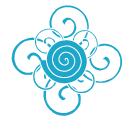
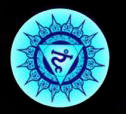
Purity, ethics, knowledge, expanded consciousness, complete harmony.
The fifth chakra is referred to as the Throat. It is located in the V of the collarbone at the lower neck and is the center of communication, sound, and expression of creativity via thought, speech, and writing. The possibility for change, transformation and healing are located here. The throat is where anger is stored and finally let go of. When this chakra is out of balance you may want to hold back, feel timid, be quiet, feel weak, or can't express your thoughts. Physical illnesses or ailments include, hyperthyroid, skin irritations, ear infections, sore throat, inflammations, and back pain. When this chakra is balanced you may feel balanced, centered, musically or artistically inspired, and may be a good speaker. Body parts for the fifth chakra are throat, neck, teeth, ears, and thyroid gland. The main color used is light blue. The gemstones are Aquamarine and Azurite.
Forehead chakra / Third Eye ( Ajna )

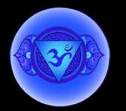
Ajna (Sanskrit: आज्ञा, ajňa, [aːɟɲʌ], meaning 'command' or 'summoning') is the sixth primary chakra according to Hindu tradition. Dissolution of duality, regulation of all mental processes; rational thinking, intuition, inspiration, memory. Human beings see themselves as a unity here - consciousness, superconsciousness, and the subconscious mind flow together.
The sixth chakra is referred to as the Third Eye. It is located above the physical eyes on the center of the forehead. This is the center for psychic ability, higher intuition, the energies of spirit and light. It also assists in the purification of negative tendencies and in the elimination of selfish attitudes. Through the power of the sixth chakra, you can receive guidance,channel, and tune into your Higher Self. When this chakra is not balanced you may feel non-assertive, afraid of success, or go the opposite way and be egotistical. Physical symptoms may include headaches, blurred vision, blindness, and eye strain. When this chakra is balanced and open you are your own master with no fear of death, are not attached to material things, may experience telepathy, astral travel, and past lives. Sixth chakra body parts include the eyes, face, brain, lymphatic and endocrine system. The main colors are purple and dark blue. The gemstones are Amethyst, Sodalite, and Lapis Lazuli.
Location
The Ajna chakra is positioned in the stomata, directly behind the center of the forehead. Its ksehtram, or superficial activation site, is in the eyebrow region at the position of the "third eye."
Appearance
Ajna is white in color, with two white petals. Inside the pericarp is the Shakti Hakini. It is depicted with a white moon, six faces, and six arms holding a book, a skull, a drum, and a rosary, while making the gestures associated with granting boons and dispelling fears. The downward pointing triangle above her contains a moon-white lingum. In some systems the deity Ardhanarishvara, a hermaphrodite form of Shiva-Shakti, symbolising the primordial duality of subject and object, resides within the lingum. Above that triangle is another smaller triangle containing the bija mantra, Aum.
Bija or Seed mantra
The seed syllable is Aum, or "Pranava Om," the supreme sound.
Petals
Adina has two white petals, said to represent the psychic channels, Ida and Pin gala, which meet the central Subhuman nadir (channel), before rising to the Crown Chakra Sahasrara. The letter 'Ham' is written in white on the left petal and represents Shiva. 'Sham', written in white on the right petal, represents Shakti. These two petals also represent the manifest and the manifest mind, and are sometimes said to represent the pineal and pituitary glands.
Function
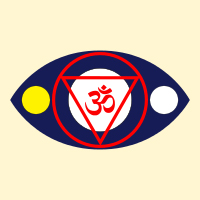
Ajna has a petal dedicated to the sun, the other to the moon.
Ajna translates as "command", and is considered the eye of intuition and intellect. When something is seen in the mind's eye, or in a dream, it is being seen by Ajna. It is a bridge that links gurus with disciples, allowing mind communication to occur between two people. The sense organ and action organ associated with Ajna is the mind.
As Hindus believe that spiritual energy from the environment enters their body through this gateway, they take great care to protect it with spiritually positive protecting forces. The various religious marks on the foreheads of men and women belonging to the Hindu faith (like holy ash, namam, vermilion etc.) are the blessed spiritual prasadam of their respective forms of the Hindu gods.
Meditation upon Ajna supposedly grants siddhis, or occult powers, to quickly enter another body at will and to become omniscient. He realizes unity with Brahman; and he has the ability to create, preserve, and destroy the three worlds.
Manas chakra
Directly above Ajna is a minor chakra known as Manas, or mind. It possesses six petals, one for each of the five senses and one for sleep. These petals are normally white, but assume the color of the senses when activated by them, and they are black during sleep. This chakra's function is sending sense perceptions to the higher chakras.
Association with the body
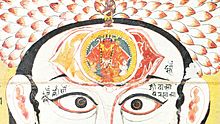
The Ajna chakra is positioned in the brain, directly behind the eyebrow center.
Activation location is at the eyebrow region, in the position of the 'third eye.'

The parietal eye (very small grey oval between the regular eyes) of a juvenile bullfrog (Rana catesbeiana)
Ajna is associated with the third eye on the forehead. It is also sometimes associated with the pineal gland, which regulates the circadian rhythm, and is related to an actual light-sensitive 'third eye' (Parietal eye) found in some lizards, amphibians, and fish. It is also sometimes associated with the pituitary gland, the master of all endocrine glands, whose secretions control all the other endocrine glands.
Practices
In kundalini yoga, the practices said to stimulate the Ajna chakra include: Trataka (steady gazing), Shambhavi Mudra (gazing at the space between the eyebrows), and some forms of Pranayama (breath exercises).
Comparisons with other systems
In Tibetan buddhism, this chakra is at the end of the central channel, which runs up the body to the top of the head, and then over and down, terminating at the forehead. The two side channels continue onwards towards the two nostrils and end there. This center is frequently depicted in artwork as the third eye, and is used in various meditations.
There is also a forehead centre above the third eye, which corresponds to the position of Manas, one of the ten chakras in the Mahayoga tantra traditions.
In Qigong, the highest Dantian is located at this position. This is one of three furnaces that converts the different sorts of energy in the body. In this Dantian, the spiritual shen energy is converted into wuji, the infinite space of void.
Within the system of Lataif-e-sitta there exists a Lataif known as Khafi, or arcane subtlety, in this same position, and is related to mystical intuition.
According to the Kabbalah, there are two sephiroth located on the sixth level, associated with the left and right parts of the face. They are called Chokmah (wisdom), and Binah (understanding); it is at these points that the two side pillars of mercy and severity terminate, while the central pillar carries on rising to kether, the crown.
Alternative names
In Tantra :
Ajita-Patra, Ajna, Ajna-Pura, Ajna-Puri, Ajnamhuja, Ajnapankaja, Bhru-Madhya, Bhru-Madhya-Chakra, Bhru-Madhyaga-Padma, Bhru-Mandala, Bhru-Mula, Bhru-Saroruha, Dwidala, Dwidala-Kamala, Dwidalambuja, Dwipatra, Jnana-Padma, Netra-Padma, Netra-Patra, Shiva-Padma, and Triweni-Kamala
In the Vedas, Upanishads :
Ajna, Baindawa-Sthana, Bhru Chakra, Bhruyugamadhyabila, and Dwidala
In the Puranas :
Ajna, Dwidala, and Trirasna
| Data Arrangement, Technical Arrangement & Graphics |
|---|
| Guruji Murugan Chillayah - Silambam Asia |
| References |
| Guruji Murugan Chillayah. (2012). Teaching and Essence of Indian Traditional Arts of Silambam, Varma Kalai and Traditional Yoga from Himalaya Mountain. Silambam Asia. https://silambam.asia |
| Swami Satyananda Saraswati. Kundalini Tantra |
| Shyam Sundar Goswani. Layayoga – an advanced method of concentration |
| page 268, Kundalini Yoga for the West, Swami Sivananda Radha, Copyright 1978, Shambala Publications, Inc. |
| "Third Eye Chakra". ASIS Massage. Retrieved 25 July 2013. |
| Geshe Kelsang Gyatso. Tantric Grounds and Paths |
| Andy James. The Spiritual Legacy of Shaolin Temple |
| Dion Fortune. The Mystical Qabalah |
Crown chakra ( Sahasrara )

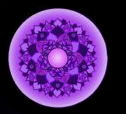
State of bliss, the individual consciousness connects with the cosmic consciousness here.
The seventh chakra is referred to as the Crown. It is located just behind the top of the skull. It is the center of spirituality, enlightenment, dynamic thought and energy. It allows for the inward flow of wisdom, and brings the gift of cosmic consciousness. This is also the center of connection with the Goddess (God), the place where life animates the physical body. The silver cord that connects the aura bodies extends from the crown. The soul comes into the body through the crown at birth and leaves from the crown at death. When this chakra is unbalanced there may be a constant sense of frustration, no spark of joy, and destructive feelings. Illnesses may include migraine headaches and depression. Balanced energy in this chakra may include the ability to open up to the Divine and total access to the unconscious and subconscious. The main colors for the crown are white and purple. The gemstones are Clear Quartz Crystal, Oregon Opal, and Amethyst.
Chakras
The word chakra is derived from the Sanskrit word meaning wheel. If we were able to see the chakras ( as many psychics, in fact, do ) we would observe a wheel of energy continuously revolving or rotating.
The Sound of the Chakras - "Lam, Vam, Ram, Yam, Ham, Om, Om" each accordingly to each chakra ( from bottom to top ). We created this image for easier to understand.
The Chakras and the Corresponding Talents and Traits

Courtesy : This chakra designed with comprehensive details by Guruji Murugan Chillayah, for easy understanding.
Part I - Study of the Chakras
The word chakra is derived from the Sanskrit word meaning wheel. If we were able to see the chakras ( as many psychics, in fact, do ) we would observe a wheel of energy continuously revolving or rotating. Clairvoyants perceive chakras as colorful wheels or flowers with a hub in the center. The chakras begin at the base of the spine and finish at the top of the head. Though fixed in the central spinal column they are located on both the front and back of the body, and work through it.
Each chakra vibrates or rotates at a different speed. The root or first chakra rotates at the slowest speed, the crown or seventh chakra at the highest speed. Each chakra is stimulated by its own and complimentary color, and a range of gemstones for specific uses. The chakra colors are of the rainbow; red, orange, yellow, green, blue, indigo, and violet. The size and brightness of the wheels vary with individual development, physical condition, energy levels, disease, or stress.
If the chakras are not balanced, or if the energies are blocked, the basic life force will be slowed down. The individual may feel listless, tired, out of sorts, or depressed. Not only will physical bodily functions be affected so diseases may manifest, but the thought processes and the mind may also be affected. A negative attitude, fear, doubt, etc. may pre-occupy the individual.
A constant balance between the chakras promotes health and a sense of well-being. If the chakras are opened to much, a person could literally short-circuit themselves with too much universal energy going through the body. If the chakras are closed, this does not allow for the universal energy to flow through them properly which may also lead to disease.
Most of us react to unpleasant experiences by blocking our feeling and stopping a great deal of our natural energy flow. This affects the maturation and development of the chakras. Whenever a person blocks whatever experience he is having, he in turn blocks his chakras, which eventually become disfigured. When the chakras are functioning normally, each will be open, spinning clockwise to metabolize the particular energies needed from the universal energy field.
As already mentioned any imbalances that exist within any chakra may have profound effects upon either our physical or emotional bodies. We are able to use our quartz crystals and gemstones to re-balance all our chakric centers and once the chakra has been properly balanced then our body will gradually return to normal.
The reason why crystals and gemstones are wonderful and powerful healing tools are because of what science calls its piezoelectric effect. ( You can see this effect in the modern quartz watches ). Crystals and gemstones respond to the electricity that is coursing through our body, and if the energy is sluggish,the constant electrical vibrations of the stones will help to harmonize, balance, and stimulate these energies.
Root chakra ( Muladhara )


Vitality, a sense of connection with Earth, basic trust, self-confidence, a sense of security in harmony with the laws of nature.
Studying the individual chakras begins with the root chakra, called Muladhara in Sanskrit. The root chakra is located at the base of the spine at the tail-bone in back, and the pubic bone in front. This center holds the basic needs for survival, security and safety. The root chakra is powerfully related to our contact with the Earth Mother, providing us with the ability to background into the earth plane. This is also the center of manifestation. When you are trying to make things happen in the material world, business or material possessions, the energy to succeed will come from the first chakra. If this chakra is blocked an individual may feel fearful, anxious, insecure and frustrated. Problems like obesity, anorexia nervosa, and knee troubles can occur. Root body parts include the hips, legs, lower back and sexual organs. The colors used for this chakra are red, brown and black. The gemstones are Garnet, Smoky Quartz, Obsidian, and Black Tourmaline.
Belly (Sacral) chakra ( Swadhisthana )


Survival of the species, sexuality, family, sociableness, creativity, solidarity with the surrounding world.
The next chakra or second chakra is often referred to as the belly or (sacral). It is located two inches below the navel and is rooted into the spine. This center holds the basic needs for sexuality, creativity, intuition, and self-worth. This chakra is also about friendliness, creativity, and emotions. It governs peoples sense of self-worth, their confidence in their own creativity, and their ability to relate to others in an open and friendly way. It's influenced by how emotions were expressed or repressed in the family during childhood. Proper balance in this chakra means the ability to flow with emotions freely and to feel and reach out to others sexually or not. If this chakra is blocked a person may feel emotionally explosive, manipulative, obsessed with thoughts of sex or may lack energy. Physical problems may include, kidney weakness, stiff lower back, constipation, and muscle spasms. Belly body parts include sexual organs (women), kidneys, bladder, and large intestine. The main color used with this chakra is orange. The gemstones are Carnelian Agate, Orange Calcite and Tigers Eye.
Solar plexus chakra ( Manipuraka )


Powers of imagination, visions of the future, desire for action, coming to terms with the past, decomposition; the inner fire that creates and destroys.
The third chakra is referred to as the Solar Plexus. It is located two inches below the breastbone in the center behind the stomach. The third chakra is the center of personal power, the place of ego, of passions, impulses, anger and strength. It is also the center for astral travel and astral influences,receptivity of spirit guides and for psychic development. When the Third Chakra is out of balance you may lack confidence, be confused, worry about what others think, feel that others are controlling your life, and may be depressed. Physical problems may include digestive difficulties, liver problems, diabetes, nervous exhaustion, and food allergies. When balanced you may feel cheerful,outgoing, have self-respect, expressive, enjoy taking on new challenges, and have a strong sense of personal power. The body parts for this chakra include the stomach, liver, gall bladder, pancreas, and small intestine. The main color for this chakra is yellow. The gemstones are Citrine, Topaz, and Yellow Calcite.
Heart chakra ( Anahata )


Love of life, joy, love, affection; source of unconditional, selfless love toward fellow human beings, every creature, every element, and the entire Creation.
The fourth chakra is referred to as the heart chakra. It is located behind the breast bone in front and on the spine between the shoulder blades in back. This is the center for love, compassion and spirituality. This center directs one's ability to love themselves and others, to give and to receive love. This is also the chakra connecting body and mind with spirit. Almost everyone today has a hard, hurt, or broken heart, and it is no accident that heart disease is the number one killer in America today. Deep heart hurts can result in aura obstructions called heart scars. When these scars are released, they raise alot of old pain, but free the heart for healing and new growth. When this chakra is out of balance you may feel sorry for yourself, paranoid, indecisive, afraid of letting go, afraid of getting hurt, or unworthy of love. Physical illnesses include heart attack, high blood pressure, insomnia, and difficulty in breathing. When this chakra is balanced you may feel compassionate, friendly, empathetic, desire to nurture others and see the good in everyone. Body parts for the fourth chakra include heart, lungs, circulatory system, shoulders, and upper back. The main colors used are pink and green. The gemstones are Rose Quartz, Kunzite, and Watermelon tourmaline.
Throat chakra ( Vishuddha )


Purity, ethics, knowledge, expanded consciousness, complete harmony.
The fifth chakra is referred to as the Throat. It is located in the V of the collarbone at the lower neck and is the center of communication, sound, and expression of creativity via thought, speech, and writing. The possibility for change, transformation and healing are located here. The throat is where anger is stored and finally let go of. When this chakra is out of balance you may want to hold back, feel timid, be quiet, feel weak, or can't express your thoughts. Physical illnesses or ailments include, hyperthyroid, skin irritations, ear infections, sore throat, inflammations, and back pain. When this chakra is balanced you may feel balanced, centered, musically or artistically inspired, and may be a good speaker. Body parts for the fifth chakra are throat, neck, teeth, ears, and thyroid gland. The main color used is light blue. The gemstones are Aquamarine and Azurite.
Forehead chakra / Third Eye ( Ajna )


Ajna (Sanskrit: आज्ञा, ajňa, [aːɟɲʌ], meaning 'command' or 'summoning') is the sixth primary chakra according to Hindu tradition. Dissolution of duality, regulation of all mental processes; rational thinking, intuition, inspiration, memory. Human beings see themselves as a unity here - consciousness, superconsciousness, and the subconscious mind flow together.
The sixth chakra is referred to as the Third Eye. It is located above the physical eyes on the center of the forehead. This is the center for psychic ability, higher intuition, the energies of spirit and light. It also assists in the purification of negative tendencies and in the elimination of selfish attitudes. Through the power of the sixth chakra, you can receive guidance,channel, and tune into your Higher Self. When this chakra is not balanced you may feel non-assertive, afraid of success, or go the opposite way and be egotistical. Physical symptoms may include headaches, blurred vision, blindness, and eye strain. When this chakra is balanced and open you are your own master with no fear of death, are not attached to material things, may experience telepathy, astral travel, and past lives. Sixth chakra body parts include the eyes, face, brain, lymphatic and endocrine system. The main colors are purple and dark blue. The gemstones are Amethyst, Sodalite, and Lapis Lazuli.
Location
The Ajna chakra is positioned in the stomata, directly behind the center of the forehead. Its ksehtram, or superficial activation site, is in the eyebrow region at the position of the "third eye."
Appearance
Ajna is white in color, with two white petals. Inside the pericarp is the Shakti Hakini. It is depicted with a white moon, six faces, and six arms holding a book, a skull, a drum, and a rosary, while making the gestures associated with granting boons and dispelling fears. The downward pointing triangle above her contains a moon-white lingum. In some systems the deity Ardhanarishvara, a hermaphrodite form of Shiva-Shakti, symbolising the primordial duality of subject and object, resides within the lingum. Above that triangle is another smaller triangle containing the bija mantra, Aum.
Bija or Seed mantra
The seed syllable is Aum, or "Pranava Om," the supreme sound.
Petals
Adina has two white petals, said to represent the psychic channels, Ida and Pin gala, which meet the central Subhuman nadir (channel), before rising to the Crown Chakra Sahasrara. The letter 'Ham' is written in white on the left petal and represents Shiva. 'Sham', written in white on the right petal, represents Shakti. These two petals also represent the manifest and the manifest mind, and are sometimes said to represent the pineal and pituitary glands.
Function

Ajna has a petal dedicated to the sun, the other to the moon.
Ajna translates as "command", and is considered the eye of intuition and intellect. When something is seen in the mind's eye, or in a dream, it is being seen by Ajna. It is a bridge that links gurus with disciples, allowing mind communication to occur between two people. The sense organ and action organ associated with Ajna is the mind.
As Hindus believe that spiritual energy from the environment enters their body through this gateway, they take great care to protect it with spiritually positive protecting forces. The various religious marks on the foreheads of men and women belonging to the Hindu faith (like holy ash, namam, vermilion etc.) are the blessed spiritual prasadam of their respective forms of the Hindu gods.
Meditation upon Ajna supposedly grants siddhis, or occult powers, to quickly enter another body at will and to become omniscient. He realizes unity with Brahman; and he has the ability to create, preserve, and destroy the three worlds.
Manas chakra
Directly above Ajna is a minor chakra known as Manas, or mind. It possesses six petals, one for each of the five senses and one for sleep. These petals are normally white, but assume the color of the senses when activated by them, and they are black during sleep. This chakra's function is sending sense perceptions to the higher chakras.
Association with the body

The Ajna chakra is positioned in the brain, directly behind the eyebrow center.
Activation location is at the eyebrow region, in the position of the 'third eye.'

The parietal eye (very small grey oval between the regular eyes) of a juvenile bullfrog (Rana catesbeiana)
Ajna is associated with the third eye on the forehead. It is also sometimes associated with the pineal gland, which regulates the circadian rhythm, and is related to an actual light-sensitive 'third eye' (Parietal eye) found in some lizards, amphibians, and fish. It is also sometimes associated with the pituitary gland, the master of all endocrine glands, whose secretions control all the other endocrine glands.
Practices
In kundalini yoga, the practices said to stimulate the Ajna chakra include: Trataka (steady gazing), Shambhavi Mudra (gazing at the space between the eyebrows), and some forms of Pranayama (breath exercises).
Comparisons with other systems
In Tibetan buddhism, this chakra is at the end of the central channel, which runs up the body to the top of the head, and then over and down, terminating at the forehead. The two side channels continue onwards towards the two nostrils and end there. This center is frequently depicted in artwork as the third eye, and is used in various meditations.
There is also a forehead centre above the third eye, which corresponds to the position of Manas, one of the ten chakras in the Mahayoga tantra traditions.
In Qigong, the highest Dantian is located at this position. This is one of three furnaces that converts the different sorts of energy in the body. In this Dantian, the spiritual shen energy is converted into wuji, the infinite space of void.
Within the system of Lataif-e-sitta there exists a Lataif known as Khafi, or arcane subtlety, in this same position, and is related to mystical intuition.
According to the Kabbalah, there are two sephiroth located on the sixth level, associated with the left and right parts of the face. They are called Chokmah (wisdom), and Binah (understanding); it is at these points that the two side pillars of mercy and severity terminate, while the central pillar carries on rising to kether, the crown.
Alternative names
In Tantra :
Ajita-Patra, Ajna, Ajna-Pura, Ajna-Puri, Ajnamhuja, Ajnapankaja, Bhru-Madhya, Bhru-Madhya-Chakra, Bhru-Madhyaga-Padma, Bhru-Mandala, Bhru-Mula, Bhru-Saroruha, Dwidala, Dwidala-Kamala, Dwidalambuja, Dwipatra, Jnana-Padma, Netra-Padma, Netra-Patra, Shiva-Padma, and Triweni-Kamala
In the Vedas, Upanishads :
Ajna, Baindawa-Sthana, Bhru Chakra, Bhruyugamadhyabila, and Dwidala
In the Puranas :
Ajna, Dwidala, and Trirasna
| Data Arrangement, Technical Arrangement & Graphics |
|---|
| Guruji Murugan Chillayah - Silambam Asia |
| References |
| Guruji Murugan Chillayah. (2012). Teaching and Essence of Indian Traditional Arts of Silambam, Varma Kalai and Traditional Yoga from Himalaya Mountain. Silambam Asia. https://silambam.asia |
| Swami Satyananda Saraswati. Kundalini Tantra |
| Shyam Sundar Goswani. Layayoga – an advanced method of concentration |
| page 268, Kundalini Yoga for the West, Swami Sivananda Radha, Copyright 1978, Shambala Publications, Inc. |
| "Third Eye Chakra". ASIS Massage. Retrieved 25 July 2013. |
| Geshe Kelsang Gyatso. Tantric Grounds and Paths |
| Andy James. The Spiritual Legacy of Shaolin Temple |
| Dion Fortune. The Mystical Qabalah |
Crown chakra ( Sahasrara )


State of bliss, the individual consciousness connects with the cosmic consciousness here.
The seventh chakra is referred to as the Crown. It is located just behind the top of the skull. It is the center of spirituality, enlightenment, dynamic thought and energy. It allows for the inward flow of wisdom, and brings the gift of cosmic consciousness. This is also the center of connection with the Goddess (God), the place where life animates the physical body. The silver cord that connects the aura bodies extends from the crown. The soul comes into the body through the crown at birth and leaves from the crown at death. When this chakra is unbalanced there may be a constant sense of frustration, no spark of joy, and destructive feelings. Illnesses may include migraine headaches and depression. Balanced energy in this chakra may include the ability to open up to the Divine and total access to the unconscious and subconscious. The main colors for the crown are white and purple. The gemstones are Clear Quartz Crystal, Oregon Opal, and Amethyst.
Silambam Asia (SILA) is in official partnership with the United Nations Sustainable Development Goals (UN-SDGS) to preserve and safeguard the Indian traditional arts, sports, cultural, and educational content of Silambam at the international level.
Silambam Asia plays active roles as an international organization for governance and sustainable development in the Indian traditional arts and sports for education, health, fitness, culture, nature, climate change, recreation, and dissemination of all these related information. Thus, it is vital to provide expertise for members by providing training, research, revive, rejuvenate, retain, and restore.
The mission of Silambam Asia is to provide effective international governance by constantly improving technical rules and regulating Silambam competitions or participation in international events or sporting arenas to be recognized as an Olympic and Paralympic sport in the near future.
Silambam Asia - Introduction
Indian traditional arts and sports for education, health, fitness, culture, nature, climate change, recreation, and dissemination.
Video content with development work, achievements and silambam history.
We Support






Make A Difference
We always encourage everyone to join us. Get in touch with us for more support.
